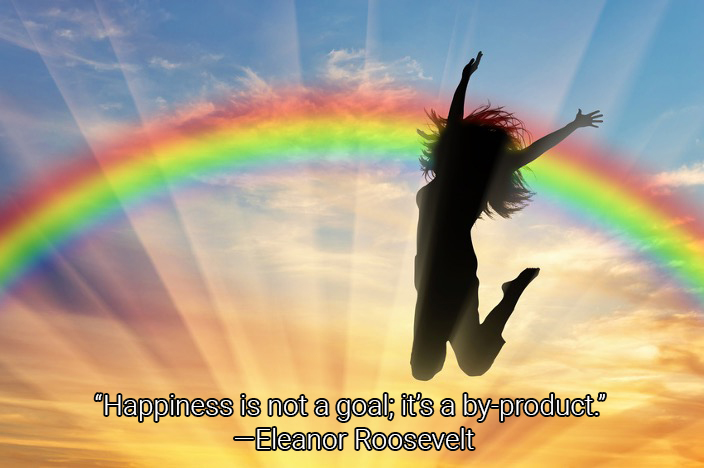
Every year thousands of books and articles are published on how to be happy—usually how to get “there” faster, or to get more of “it,” however you wish to define “there” and “it.” This is not a fad, it goes back thousands of years.
Aristotle concluded 2,300 years ago that more than anything else in life, people seek happiness, usually through beauty, money, or power—and this approach in and of itself rarely succeeds for the long haul.
Why? For one thing, happiness cannot be achieved directly as a goal. It’s always the result of doing something—as Eleanor Roosevelt noted, it’s a by-product. And that something is much more fundamental than beauty, money, and power. But then, how does happiness unfold? What makes us happy?
What Is Happiness?
Most dictionaries define happiness as a state of mind characterized by feelings of contentment, love, satisfaction, pleasure, or joy. There is no such thing as constant happiness, except perhaps for “enlightened” saints who spend their lives in meditative bliss.
But that’s not the path for most of us. Our lives are generally lived between the poles of joy and sorrow, laughter and sighs, achievement, and disappointment. The key is how to live a happy life on average. At the end of a day, a week, a month, a year—do you feel that deep sense of fulfillment sought by the spirit inside you?
If happiness is not a goal, then what leads to happiness? I think we certainly must live by our values, those guidelines ingrained in us that set the internal compass by which we live. Those values may vary with the person. However, when we violate any them, we feel stressed and unhappy. But following your values is not enough to achieve lasting fulfillment.
The Path to Happiness
I think the fundamental requirement is that you continuously pursue your sense of Purpose, your raison d’être, as the French would say. This means applying your strengths, or what I call your Essence to create value for both the world and for you. Each of us is born with a personal Essence, a capability or skill that differentiates us from others. It’s something we’re good at and love to do. It’s the force behind Do what you love and love what you do! And when you find a way to apply it to make the world a better place, it generates Passion—a force that evaporates fear, unleashes Creativity, and can really make a difference.
Paulo Coelho, author of The Alchemist, tells us we know what our Essence is when we are young, somewhere between the ages of 5 and 15. But the ways of the world can sometimes dull our senses, and by the time we’re adults, if we haven’t made good use of it, we may either forget what that asset is, or perhaps, we’ve been talked out of it—“Sure you’re talented at art, but how are you going to make a living?” You don’t have to be a Picasso. How about an illustrator, a draftsperson, gallery owner, graphic designer and more?
We don’t think in these terms when we’re young, but that skill is there, and it can be kindled in a most unexpected way. A personal story. I’ve had a lifelong passion for technology and entertainment. I discovered both of these passions between 9 and 12 years of age.
My interest in technology was precipitated with a Christmas gift of a chemistry set, shortly before my 9th birthday. I’m not sure I would give a 9 year-old a chemistry set today, but my parents wanted me to become a physician, but it wasn’t my interest. They thought that perhaps a chemistry set might guide me in that direction.
After doing all of the usual “boys’ stuff” like making stink bombs, rockets, and fireworks, I found I could make useful products such as ink, adhesives, cleaners, and simple cosmetics. I set up a small lab in the basement of our home and began making products and selling them in the neighborhood. Every cent I made went into my laboratory. It was a marvelous experience—people were actually willing to pay for products I made using my “technology!”
This filled me with Passion and as a result, science and technology have remained an important part of my professional world, ever since.
My deep interest in entertainment happened in a similar manner. Growing up in New Jersey during the frigid winters of the 1950s, and as the oldest of 10 children from parents of modest means, I went to work when I was 10 years old delivering newspapers. But, I wanted an “inside” job away from the cold Jersey winters, so I took some piano lessons and started a band playing for school dances, parties, and weddings.
As a teenager living next to New York City, the capital of rock ‘n roll music during the 1950s, I began to write songs and sell them to recording groups in the city. One thing led to another and at age 16, our group became recording artists. We recorded several singles and a couple of albums. We worked with many of the early pioneers of rock ‘n roll music—from Chuck Berry to Jerry Lee Lewis to Buddy Holly and the Crickets.
I’ve seen this kind of journey played out over and over again for people who say they have happy and fulfilled lives. Here’s the overall path in summary:
Essence -> Purpose -> Need -> Passion -> Energy -> Creativity -> Innovation -> Reward -> Gratefulness -> FULFILLMENT & HAPPINESS
First you must find your Essence, what you’re good at—that’s the easy part. Then the more challenging part—Purpose. How can I apply my skills to a Need in the world that makes a difference? That generates Passion, which gives you lots of physical and emotional Energy. You suddenly become more creative than you can recall, unleashing Innovation. You find solutions to tough problem you previously thought unsolvable, and that eventually leads to a Reward—it may be financial, emotional, spiritual, or some combination. That finally opens up a feeling of Gratefulness, which is the source of long-term FULFILLMENT and HAPPINESS.
The nice thing about this process is that you don’t have to wait to the end of the process to enjoy your life. Once you ignite your passion for what you’re doing, it will follow you throughout and always be there to get you through the tough times—and there will always be some. How does this apply to business?
Business And The Formula of Five
The most successful businesses place their employees in jobs and an environment that is effective in tapping into their Essence and Purpose. Numerous studies of employee engagement show that only about 20 percent of employees enjoy their job. Why is that? A lack of purpose causes anxiety and people then work inefficiently. Can you imagine the level of productivity and sense of fulfillment if a business were to tap into employees’ Essence and Purpose? This would be the ultimate competitive advantage!
So then, what instills and reinforces a sense of Purpose in business? I call it the “Formula of Five.”
1. The employer must present a vision that captures the employees’ excitement and assure that they are in jobs that draw on their strengths. The challenge must draw on an employee’s Essence. It does no good to ask a plumber to do an electrician’s job. If you are an employer, the key is to work with employees to uncover their strengths. The investment is worth the effort.
2. The job must appeal to the person’s need to “help the greater good.” Almost everyone wants to make a positive difference in the world. Whether the business is a small retailer or a large healthcare company, it’s possible to show employees that they’re making a difference.
3. There should be a good probability of success in achieving their goals. No one wants to work hard without some level of accomplishment.
4. Employees should have a reasonable level of autonomy. It’s best to higher good people, give them a set of specific goals that support the company, and then let them decide how best to get the work done.
5. Employees should share in any success that they help achieve. This could include public and private feedback, a raise, bonus, stock options, or profit sharing at year end.
Final Thoughts
As stated so well by Steve Jobs in his commencement address to the 2005 graduating class at Stanford University:
1. Don’t waste your time trying to live someone else’s life. Early on, you likely know what drives you. It is important to follow that voice inside.
2. Don’t be trapped by dogma—living blindly with other people’s thinking. Yes, listen to others and integrate their thinking into your own as you see fit. However, rarely does “It can’t be done!” turn out to be correct. Running the mile in less than 4 minutes was once thought to be impossible, until Roger Bannister broke that record on May 6, 1954. Subsequently, several other runners broke the record after “they knew it could be done!”
3. Don’t let the noise of opinion drown out your inner voice. Have courage to follow your intuition. That little computer and compass inside knows your “true north.” You are an incredibly special machine.
Enjoy your journey; make a difference!
Namaste,

Chairman & Owner, Chateau Mcely
www.JimTheAlchymist.Com
Chateau Mcely
“The Dialogue—A Journey to Universal Truth”
“Life Is Beautiful: 12 Universal Rules”

